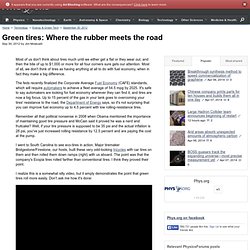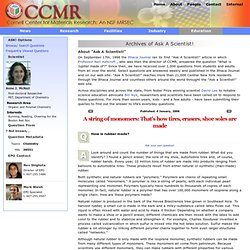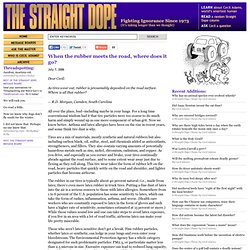

Rubber Production Procdure from Trees to Sheet at Ruso, Narathiwat, Thailand. Environmental Effects of Rubber Mulch. Zenith Rubber Manufacturing Overview. Green tires: Where the rubber meets the road. Most of us don't think about tires much until we either get a flat or they wear out, and then the bite of up to $1,000 or more for all four corners sure gets our attention.

Most of all, we don't think of tires as having anything at all to do with fuel economy, when in fact they make a big difference. The feds recently finalized the Corporate Average Fuel Economy (CAFE) standards, which will require automakers to achieve a fleet average of 54.5 mpg by 2025. It's safe to say automakers are looking for fuel economy wherever they can find it, and tires are now a big focus. Up to 15 percent of the gas in your tank goes to overcoming your tires' resistance to the road, the Department of Energy says, so it's not surprising that you can improve fuel economy up to 4.5 percent with low rolling-resistance tires.
Remember all that political nonsense in 2008 when Obama mentioned the importance of maintaining good tire pressure and McCain said it proved he was a nerd and fruitcake? A Brief History of Rubber. CCMR - Ask A Scientist! About "Ask A Scientist!

" On September 17th, 1998 the Ithaca Journal ran its first "Ask A Scientist! " article in which Professor Neil Ashcroft , who was then the director of CCMR, answered the question "What is Jupiter made of? " Since then, we have received over 1,000 questions from students and adults from all over the world. Select questions are answered weekly and published in the Ithaca Journal and on our web site. "Ask A Scientist! " Across disciplines and across the state, from Nobel Prize winning scientist David Lee to notable science education advocate Bill Nye, researchers and scientists have been called on to respond to these questions. When the rubber meets the road, where does it go? July 7, 2006 Dear Cecil: As tires wear out, rubber is presumably deposited on the road surface.

Where is all that rubber? — R.D. Morgan, Camden, South Carolina All over the place, bud--including maybe in your lungs. Tires are a mix of materials, mostly synthetic and natural rubbers but also including carbon black, oil, sulfur, steel, and chemicals added as antioxidants, strengtheners, and fillers. The rubber in car tires is typically about 40 percent natural--i.e., made from latex; there's even more latex rubber in truck tires. Those who aren't latex-sensitive don't get a break.
Tire dust that doesn't make it into the air can be problematic as well. The rubber tree. Published by arrangement with the Institut africain pour le développement économique et social B.P. 8008, Abidjan, Côte d'Ivoire First printing 1977 Twenty-six titles have been published in this series, designed as handbooks for a two-year intermediate level agricultural education and training course.

They may be purchased as a set or as individual documents. The plant: the living plant; the rootThe plant: the stem; the buds; the leavesThe plant: the flowerThe soil: how the soil is made upThe soil: how to conserve the soilThe soil: how to improve the soilCrop farmingAnimal husbandry: feeding and care of animalsAnimal husbandry: animal diseases; how animals reproduce The farm business surveyCattle breedingSheep and goat breedingKeeping chickensFarming with animal powerCerealsRoots and tubersGroundnutsBananasMarket gardeningUpland riceWet paddy or swamp riceCocoaCoffeeThe oil palmThe rubber treeThe modern farm business The author of this English version is Mr.
The rubber tree. Charles Goodyear - The History of Vulcanized Rubber and Charles Goodyear. Caoutchouc was the name for rubber used by the Indians of Central and South America.

History of Caoutchouc A natural substance that had been used for centuries before being rediscovered by Columbus and introduced to western culture. Caoutchouc came from the Indian word “cahuchu,” which meant “weeping wood.” How Rubber Works" "I'm rubber, and you're glue.

Whatever you say bounces off me and sticks to you. " Although you probably remember this saying from when you were a smart-alecky kid, it's an apt description for the substance we know as rubber. The peoples of Mesoamerica, an ancient region of Central America and Mexico, are thought to be the first to have used this elastic chemical compound. They used rubber to make balls for a game that Columbus, and later the Spanish conquistadors, watched them play. To these peoples, rubber was called "caoutchouc. " Rubber is a specific type of polymer called an elastomer: a large molecule that can be stretched to at least twice its original length and returned to its original shape. Since that time, rubber has become an important natural polymer in society. Natural rubber. This article is about the polymeric material "natural rubber".

For man-made rubber materials, see Synthetic rubber. Natural rubber, also called India rubber or caoutchouc, as initially produced, consists of polymers of the organic compound isoprene, with minor impurities of other organic compounds plus water. Forms of polyisoprene that are used as natural rubbers are classified as elastomers. Currently, rubber is harvested mainly in the form of the latex from certain trees. The latex is a sticky, milky colloid drawn off by making incisions into the bark and collecting the fluid in vessels in a process called "tapping". Varieties[edit]